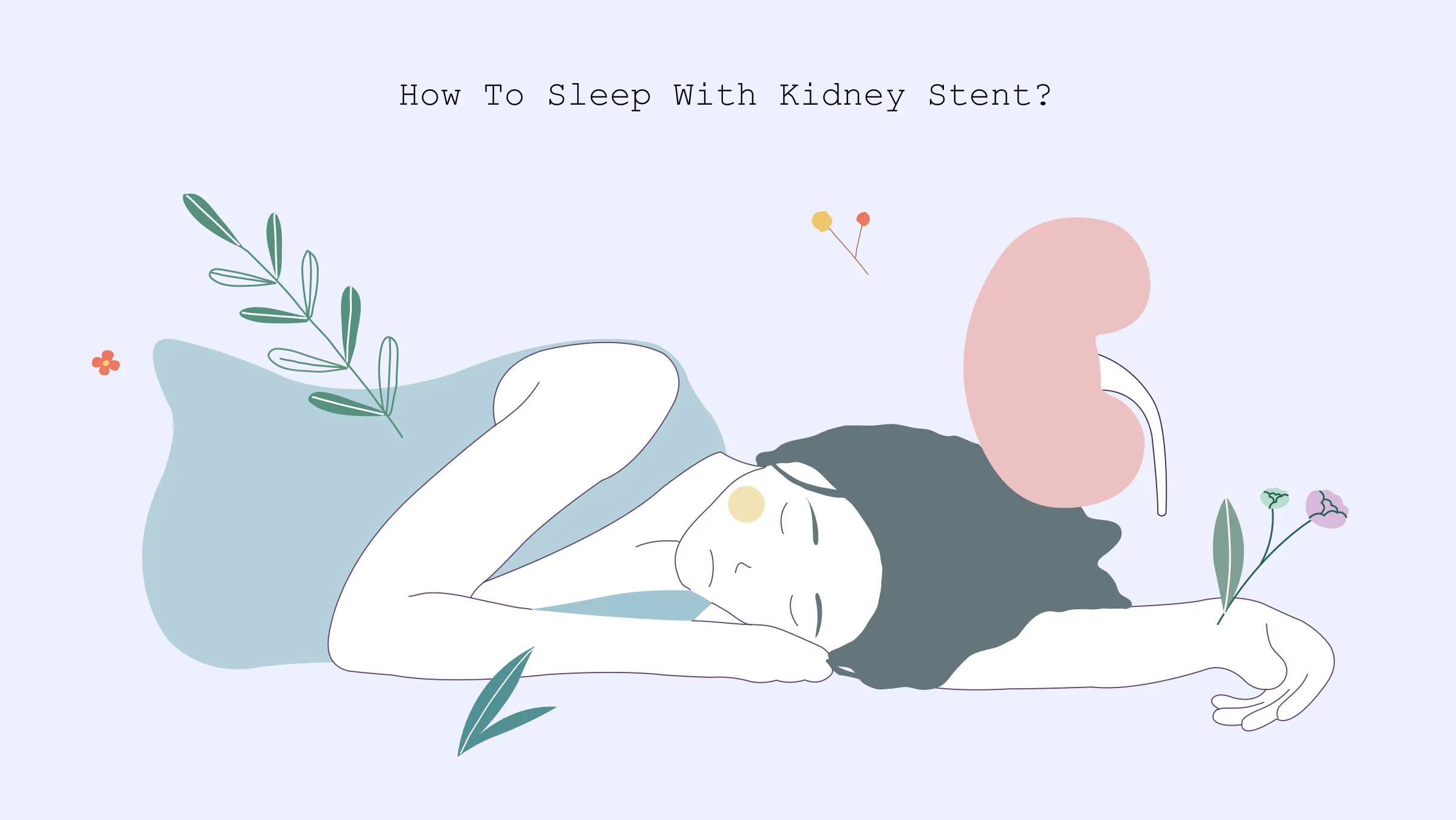How to Sleep With a Kidney Stent: Tips and Tricks
Written by

Medical reviewed by


Sleep doesn’t come easy with a stent in your kidney and too much pain. Therefore, knowing how to sleep with a kidney stent is necessary to get comfortable and healthy sleep. Sleep Guides India will help you explore the ins and outs of sleeping with a kidney stent: when and why they are inserted, side effects and comfortable sleeping positions.
What is a Kidney Stent
A kidney stent is a small, tube-like device inserted into the ureter to help relieve urinary obstruction caused by kidney stones. The stent is usually placed during a ureteroscopy procedure, which involves passing a narrow, flexible scope through the urinary tract to the stone.
Once the stone is located, the stent is positioned over the stone and then removed. It
may also be used post-surgery to help keep the ureter open and prevent its recurrence. In this case, you should go for the best position to sleep in after kidney surgery to get proper rest. If you have been diagnosed with a kidney stone, consult a doctor to discuss your treatment options and determine if a kidney stent would help you.
When Are Kidney Stents Inserted, and What Are the Challenges?
Kidney stents are often inserted during angioplasty, a procedure used to treat the narrowing of the arteries. However, the stent may be placed in some cases before angioplasty. Kidney stents are most commonly used to treat blockages in the renal artery, causing high blood pressure or kidney failure.
There are a few challenges associated with kidney stent insertion. First, the procedure can be painful, so patients may be given a local anaesthetic. Second, there is a risk of infection at the site of insertion and the stent becoming dislodged, causing further blockages in the urinary tract.
How to Sleep with A Kidney Stent
If you have a kidney stone, getting comfortable sleep can be quite challenging. Here are a few tips and tricks to help you sleep better –
Alpha-Blockers
If you have a kidney stent, your doctor may prescribe an alpha-blocker. These medications help relax the muscles around the stent and make urination easier. They are generally consumed once daily, 30 minutes after a meal.
It’s important to follow your doctor’s instructions when taking an alpha-blocker. However, they can cause side effects like dizziness or lightheadedness. Therefore, it’s best to take them at bedtime.
Anticholinergic Medications
Anticholinergic medications can help prevent or relieve muscle spasms by blocking the neurotransmitter acetylcholine. This neurotransmitter is responsible for sending signals between nerves and muscles. Muscles cannot contract strongly when blocked despite adopting the best way to sleep with kidney stones. This can help prevent or relieve muscle spasms.
Over-the-Counter Medications
There are a few over-the-counter medications that can help manage the discomfort of a kidney stent. However, it is always recommended to speak with your doctor before taking any new medicines, even over-the-counter ones.
Sleeping on the Opposite Side of the Stent
Opting to sleep on the opposite side of the stent can offer several advantages. This position helps alleviate discomfort and reduces pressure on the stent, promoting better sleep quality. If you find it difficult to adjust to this position, using a pillow for additional support can be helpful in ensuring a comfortable sleep experience.
Avoid Physical Activity Before Bed
One of the most important things to remember when you have a kidney stent is to avoid physical activity before bed. Kidney stents can be uncomfortable, and physical activity can aggravate the stent and make it harder to sleep. If you must do any physical activity before bed, make sure to do it early in the evening.
Don’t Drink Too Much Water Before Bed
If you have a kidney stent, it’s essential to avoid drinking too much water before bed. If you drink too much water, your kidneys will have to work harder to filter it all out, and this can lead to disrupted sleep even if you are in the best sleeping position for kidney pain. Instead, drink enough water daily to stay hydrated, and stop drinking at least two hours before bedtime.
Are There Any Side Effects of a Kidney Stent
Yes, you might experience specific side effects with a kidney stent. However, the most common side effect is pain. Other potential side effects include infection, blood clotting, failure of the stent, renal insufficiency, and urinary tract obstruction. You should contact your doctor immediately if you experience any of these side effects.
Conclusion
If you’re one of the many people who have to sleep with a kidney stent, you might be wondering how to sleep with a kidney stent. Luckily, there are a few tips and tricks that can help. First, ensure you’re using a soft pillow that won’t put pressure on your back or stomach. Second, try sleeping on your side instead of your back to minimise discomfort. Finally, keep a water bottle handy if you wake up thirsty in the middle of the night. With these helpful tips, you should be able to get a good night’s sleep with your kidney stent.
FAQs
Why are kidney stents so painful?
Two “pigtail” curls, one in the kidney and one in the bladder, may be seen on the stent. The curl that is sitting in the bladder will irritate the bladder lining and cause spasms. The patient experiences a strong and sudden urge to urinate due to bladder spasms.
How long does the pain last after a kidney stent?
Additionally, ureteral spasms may cause “achy” pain in your body. This usually only lasts a few hours, but it should go away over the following two to three days. Mild discomfort can occasionally last for up to two weeks. Additionally, you might experience burning sensation while urinating and have frequent urination.
Can a kidney stent make you tired?
The majority of patients are able to go back to work the following day. If your job requires a lot of physical activity, you might easily experience kidney pain or fatigue. You might need to limit your strenuous workouts while the stent is in place if this occurs.
What to avoid after having a stent?
Until the wound has healed, most likely, your doctor will instruct you to refrain from heavy lifting and intense activities for around a week.
How painful is ureteral stent removal?
The majority of patients can go back to work the following day. You may experience pain or fatigue if your job requires a lot of physical activity.
people like this article
Written by

Medical reviewed by








